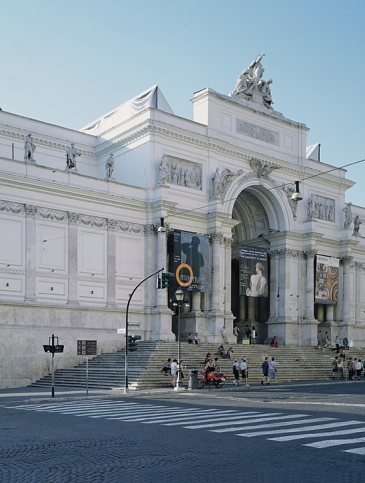



"TIME LINES" by PHILIPP GEIST
Rome Palazzo delle Esposizioni 07. / 08. September 2007
Palazzo delle Esposizioni
Via Nazionale, 194
7th REOPENING with Walter Valtroni (Mayor/ Rome)
8th Notte Bianca
To celebrate the reopening of one of Rome's most important cultural centres, on the night of September 7th, a video installation by Philipp Geist will transform the monumental façade of the building into video-architecture of dreamy digital settings and fragments of classical art; a preview of the atmosphere that will animate the interior during the Notte Bianca with creations by Metamkine, Claudio Sinatti, N!03, and PIPS:lab.
Cured by: Azienda Speciale Palaexpo, in collaborazione con Zone Attive
www.palazzoesposizioni.it
http://www.lanottebianca.it
http://www.lanottebianca.it/default.aspx?pagina=dettaglioevento_en&IdLingua=2&Nascosto=IdEventoNB&IdEventoNB=143
Cost: free of charge
Transport: BUS: 40, 60,64,70,71,116,117,170, H METRO: A fermata Repubblica
Video Installation - TIME LINES by Philipp Geist (VIDEOGEIST/ Berlin)
http://www.flickr.com/gp/8347514@N04/RhjXQ3
past projects video installation project
winterzauber - zurich
http://www.flickr.com/photos/pgeist/sets/72157600295704128/
Video Installation - TIME LINES by Philipp Geist (VIDEOGEIST/ Berlin)
Rome - Palazzo delle Esposizioni
07th / 8th September 2007 Notte Bianca
For his Video Installation TIME LINES in Rome, the Berlin-based artist Philipp Geist (born 1976) deliberately avoids the use of canvases and instead projects directly onto the concrete building façades of Plazzo delle Esposizioni. On 7th/ 8th of September, visitors can expect to see a selection of images alternating between purist, dreamlike and intangibly fragile compositions. The starting foundation for all of Philipp Geist's work is video material solely filmed and produced by himself.
Philipp Geist filmed ancient art objects, as for example statues, antique sculptures, busts, paintings, gold decoration and mosaics in Rome and Berlin, from unusual perspectives. Geist used modern digital techniques (hard- and software) to manipulate the filmed images by abstracting, recolouring and overlaying them. Elements of the art pieces are seperated from their context and arranged in new picture variants and artistic compositions. In the video installation art pieces from same and different epochs are combined. The projected moving images can be seen only on smooth surfaces in a clear and unbroken way. This fragmentary effect refers to the partial, only incompletely preserved antique art objects, and thus develops a symbiosis between the projection wall and the video art. An interaction emerges between the antique works and the contemporary, digital medium videoart on the architecture and the spectators, which both serve as projection ground.
By opting to use the three-dimensional, defined structure contours as projection surfaces instead of canvases, Geist increases the motifs abstraction while simultaneously regaining depth and diversity. In this way, Geist initiates a dialogue between the historically architecture, his artistic work and the people going in and out of the structure: The visitor himself becomes part of the projected image on the threshold between the inside and outside of the building.
The visitors make a time journey within picture worlds, which range from antiquity to the digital age.
Projekttext by Viola Fissek © 2007
